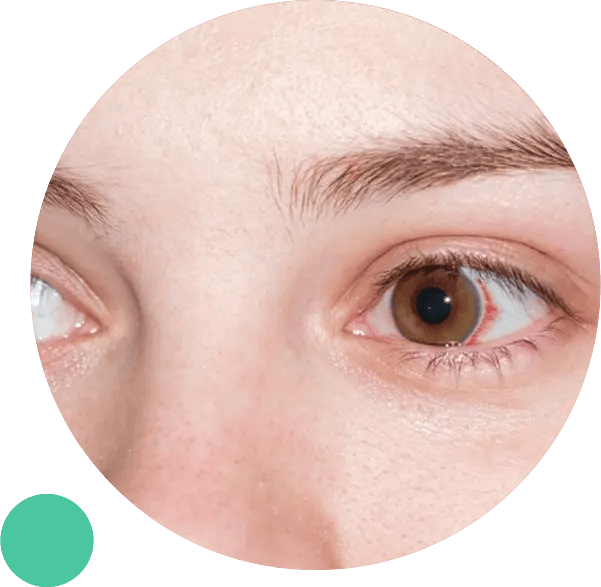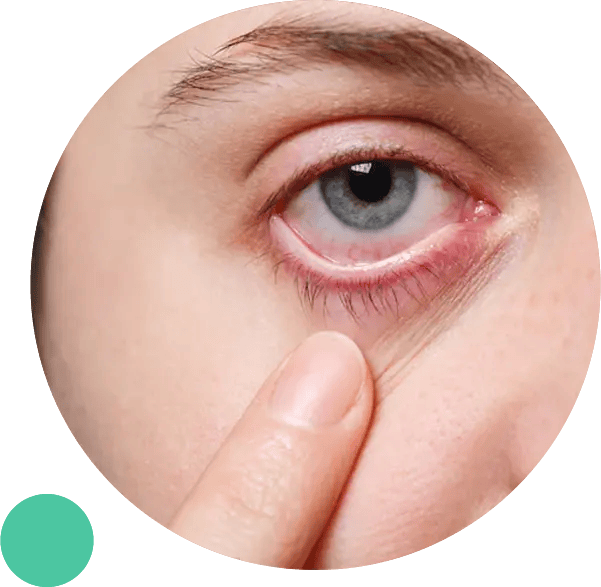

TELMDCARE
What is
Pink Eye?
Pink eye, also known as conjunctivitis, is a condition in which the conjunctiva, i.e., the thin layer of clear tissue that covers the whites of the eye, is inflamed. This membrane also lines the eyelid. The infection causes blood vessels in the membrane to become inflamed, making them more visible than usual. The inflammation, therefore, makes the eyes appear pinkish hence the term “pink eye.”
Although not particularly harmful, virtual doctors for pink eyemention that it can feel very uncomfortable and is highly contagious. It can affect both adults and children, including babies.
People may contract the infection through another affected person, or it may be caused by some other factors. Most of the time, it can be managed with treatments and an early diagnosis.
TELMDCARE
Is covered by many popular
insurance plans

Causes of
Pink Eye
Some of the most common causes of pink eye include:
- Viruses — From a common cold to coronavirus, pink eye can be caused by a variety of viruses.
- Bacteria including Pseudomonas aeruginosa, Staphylococcus aureus, and others
- Foreign objects not removed timely
- Irritants like cosmetics, contact lenses, shampoo, smoke, and pool chlorine
- Allergens including pollen, molds, etc.
- Incompletely open tear duct or a blocked one in babies
- STIs caused by a virus such as herpes simplex or a bacterial infection like chlamydia
- Fungi, parasites, or amoebas
What Does Pink Eye
Look Like? —Symptoms
Almost all types of pink eye are easily recognizable due to a large number of very apparent symptoms. Here’s what one should be looking for if you suspect a pink eye infection.
Managing Pink Eye
Symptoms at Home
Pink eye can be irritating, and symptoms can last up to 2 to 3 weeks. But there are some simple ways to relieve them.
Pink Eye
Different kinds of causes can result in different types of pink eye. Some are more common than others because of being more contagious.
Viral Strains
Viral strains are highly contagious and also the most common type. They start from one eye and cause a watery discharge and tears. But they also tend to spread to the other eye in a few days. They may also cause a swollen lymph node under the jawbone or near the ear.
Allergic Types of Pink Eye
Allergic types are less severe, but cause itching, tearing, and redness in both eyes. Some people may also experience a runny, itchy nose with this type of pink eye.
Bacterial Strains
Bacterial strains tend to get very messy due to the large quantity of pus and mucus building up. They usually occur and stay in one eye but in some cases, can affect both eyes.
Ophthalmia Neonatorum
This is a very severe type of pink eye that occurs in newborns. It’s caused by fairly harmful bacteria and can result in permanent eye damage—even blindness—if left untreated.
Giant Papillary
This is much like an allergic reaction to a chronic foreign element or body in the eye such as contacts or an ocular prosthesis (artificial eye) that can occur with long-term use.

TELMDCARE
As Seen On


TELMEDCARE
What we treat
TELMDCARE
How Long Am I
Contagious?
Pink eye contracted due to bacteria is contagious for as long as the symptoms last or about 24 to 48 hours of antibiotic treatment. Viral conjunctivitis is contagious as long as symptoms last and in some cases, it’s contagious before the first symptoms even appear.But if your pink eye is caused by an allergy, it’s likely not contagious.
Risk Factors Associated With Pink Eye
Pink eye is a viral infection of the conjunctiva (the membrane that covers the white part of the eye) and is often caused by a virus. Pink eye symptoms include redness, swelling, watery discharge, and pain.
The risk factors for pink eye are:
- Age: Being older increases your risk of contracting pink eye.
- Environmental conditions: Exposure to smoke and dust can increase your risk of developing pink eye.
- Season: The winter months are when most cases of pink eye occur.
Adults should seek immediate medical help if there’s blood in the vomit, a stiff neck, severe abdominal pain, rapid pulse, and other alarming symptoms.


Medication services available 24/7 for adults and kids (3+)

Top quality, board-certified doctors

No insurance needed

Same-day prescriptions available*
*Prescriptions provided at doctor’s discretion.

TELMDCARE
When To See A
Virtual Doctor For Pink Eye
Have you got pink eye? Don’t worry, we’ll take care of that for you.
If your eye looks red, itchy, and irritated, or if you’re constantly rubbing your eyesyou might have pink eye. Pink eye is an infection of the conjunctiva, which is the tissue surrounding your eyeball.
With our telemedicine doctor, you can get a prescription for pink eye treatment without leaving your home! Just get in touch with us and we’ll give you a diagnosis and prescription.

TELMDCARE
How To Treat Pink Eye
If you have pink eye, your online doctor for pink eyemay recommend one of the following treatments:
Antibiotics
If you have pink eye, antibiotics are the best way to treat it and prevent it from spreading. They can be taken orally or applied topically.
Ointments and Wipes
You can use ointments and wipes to keep the area clean while treating your symptoms. Ointments should be applied directly to your eyes thrice a day. Wipes should also be used for 2-3 minutes daily for atleast three consecutive days.
Eye Drops
Our online doctor may recommend eye drops for the treatment of pink eye if it is severe enough for you to notice. These drops help with the redness, swelling, and itching associated with a pink eye by reducing inflammation in the cornea.

How Can the Medical Experts at
TelMDCare Help You with
Pink Eye?
Most of the time, conjunctivitis clears up on its own and is fairly harmless. So, ourvirtual doctors for pink eye treatment will likely diagnose the type of pink eye and advice on medication and care accordingly.
However, sometimes the pink eye can become more severe and can cause long-lasting damage to the eyesight by scarring the cornea. This is usually in cases of bacterial strains like gonorrhea and chlamydia. Our physician therefore may prescribe antibiotics to clear up the infection faster. But since pinkeye typically does take 2 to 3 weeks to cure itself, it’s a good idea to set up an appointment early on so we can help you manage the symptoms.
Sign up and book an appointment with our acute care certified physicians today!
TELMDCARE
Sign Up
Our best online doctors on call ensure that the services we provide are adequate, high quality, and affordable.
Get in touch with us today for more details or Sign Up for a quick consultation.
TELMDCARE
Common FAQs Related To
Pink Eye And Its Treatment
Why is Pink Eye Called “Pink” Eye
Conjunctivitis or what’s more commonly known as pink eye is a condition that causes the blood vessels in the eye’s membrane to become swollen. This makes them unusually more visible. Giving the eye a pinkish effect, hence the name, Pink Eye.
What Isn’t Pink Eye but Looks Like It?
Seasonal allergies, iritis, a sty, or inflammations like chalazion or blepharitis all cause red, swollen, and irritated eyes—just like a pink eye infection—but these conditions have different causes and aren’t contagious.
How Does Pink Eye Spread?
Pink eye can spread from the transfer of the virus or bacteria. It could spread if a person touches their infected eye and proceeds to shake hands with another person, who touches their eye. Or it can spread by touching contaminated surfaces or by using old and unclean makeup products.Sharing anything isn’t advice during a pink eye infection.
Can I Go to School or Work with A Pink Eye?
Pink eye is just as contagious as the common cold and usually not very dangerous, so it’s okay to return to work or send your child to school. But it’s important to maintain great hygiene and limit close contact with other people while you’re still contagious.



